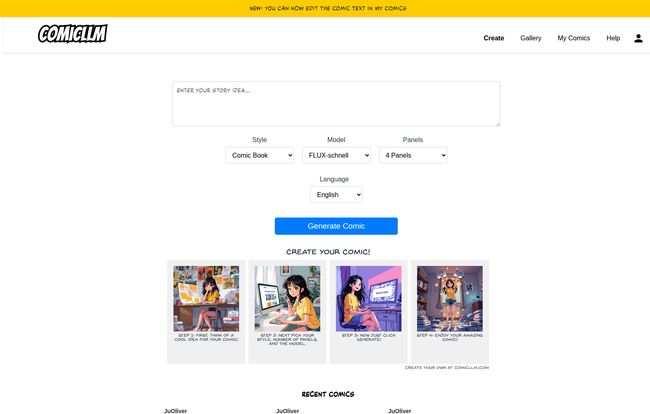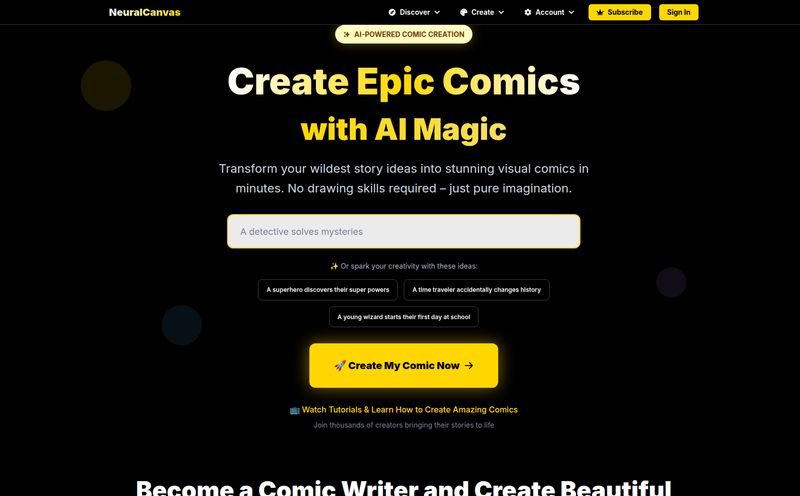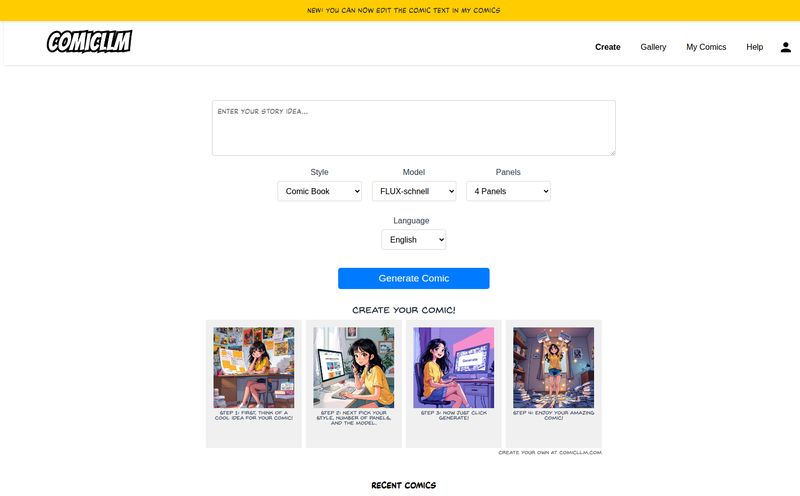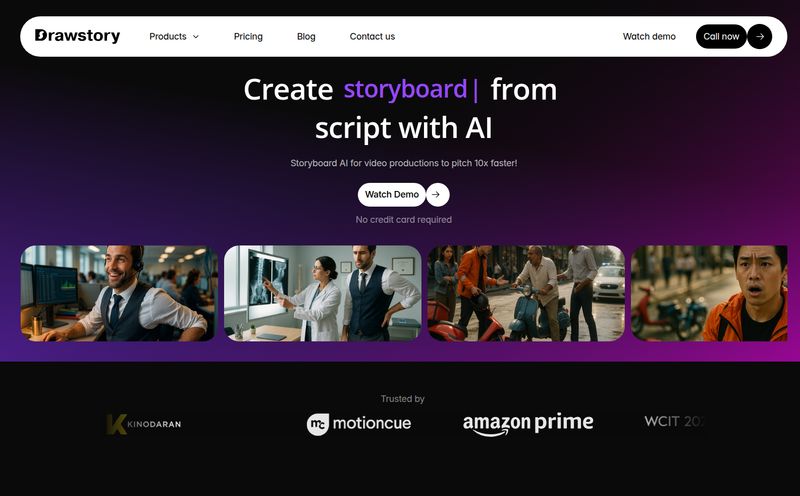I’ve been in the SEO and content game for a long time. I’ve seen trends come and go, from the keyword-stuffing dark ages to the rise of video. But the explosion of generative AI? This feels different. It's a seismic shift, and honestly, it’s both terrifying and exhilarating. Every week there's a new tool that promises to change everything. Most are hype. Some… some are genuinely interesting.
Which brings me to Comic LLM. I stumbled upon it a few weeks ago, and my first thought was, “Oh great, another AI image tool.” But the idea of it generating sequential art—a whole comic—piqued my interest. Let’s be real, most of us can’t draw a straight line with a ruler, let alone a compelling comic character. So, could a tool like this actually democratize visual storytelling? I had to find out.
So, What Exactly is Comic LLM?
In a nutshell, Comic LLM is an AI tool that turns your words into comics. You feed it a story idea, a snippet of a script, or even a news article (which is a wild concept), and it spits out a multi-panel comic strip. You're not just getting a single image; you're getting a narrative. It's designed to be a storyteller's assistant, a way to quickly visualize a concept without needing a single drop of artistic talent. Think of it less as a master artist and more as an incredibly fast, slightly unpredictable apprentice who’s eager to please.
Getting Started: A Surprisingly Simple User Experience
The first thing that struck me when I landed on the homepage was its simplicity. In a world of overly complex SaaS dashboards, this was a breath of fresh air. There's no clutter. No overwhelming menus. Just a big box that says, “ENTER YOUR STORY IDEA…”

Visit Comic LLM
The process is dead simple:
- You write your idea. I started with something basic: “A robot detective discovers his partner is a coffee machine.”
- You pick a style. The dropdown had a few options, with “Comic Book” being the default.
- You choose a model. The site listed “FLUX-schnell,” which tells me they’re likely using a specific fine-tuned image generation model. This is a neat touch for those of us who care about the tech under the hood.
- You select the number of panels. Four panels felt right for a simple gag.
- Hit “Generate Comic.” And wait.
The waiting part wasn’t long at all. In less than a minute, I had a four-panel story. It was… surprisingly coherent. Was it a masterpiece? No. But it was a complete visual narrative born from a single sentence. That’s pretty magical.
Exploring the Artistic Styles and Models
Okay, let's talk about the fun part: the styles. While the options weren't endless, the variety was decent enough to give your creations a different flavor. The “Comic Book” style delivered classic, vibrant panels with clean lines. I imagine other styles could produce anything from manga-inspired looks to more painterly, storybook aesthetics. The gallery on their homepage shows a range of outputs, from what looks like children's book illustrations to more graphic-novel-esque stuff.
This is where your prompt engineering skills come into play. The AI is interpreting your text, so the more descriptive you are, the better. Just saying “a sad man” is one thing. “A heartbroken man in a trenchcoat, standing under a single streetlamp in the pouring rain, film noir style” will give the AI much more to work with. It's a collaboration between your imagination and the machine's interpretation.
The Power of Customization: Panels and Text Editing
Being able to choose the number of panels is more important than it sounds. It dictates the pacing of your story. A quick, punchy joke might only need two or three panels. A more complex scene might need six or eight. This control over the basic structure of the comic is a great feature.
But the real game-changer, and something they’re rightly shouting about in a banner on their site, is the ability to edit the comic text. Anyone who's played with early AI image generators knows their Achilles' heel is text. You'd get gorgeous artwork ruined by garbled, nonsensical letters. Being able to go into the generated panels and fix or completely rewrite the dialogue and narration is huge. It elevates Comic LLM from a fun toy to a genuinely useful tool for creators. Finally, we can correct the AI’s weird spelling choices!
The Good, The Bad, and The AI
What I Really Liked
The speed is the first thing that blows you away. I’ve spent entire afternoons trying to storyboard a simple idea. This tool gives you a draft in seconds. It’s an incredible tool for brainstorming and rapid prototyping. The user interface is clean and intuitive, so there’s virtually no learning curve. You just go and create. And the addition of text editing, as I mentioned, is just fantastic. It shows the developers are listening to what users actually need.
Where It Gets a Little Tricky
Naturally, it’s not perfect. The biggest drawback is the classic AI dilemma: you trade control for convenience. You can't tweak a character's expression or change the camera angle in a panel. You’re at the mercy of the algorithm. Sometimes the results are brilliant, other times they're… a bit off. The quality of the output is directly tied to the quality of your input prompt. Garbage in, garbage out, as the old saying goes. It takes some practice to learn how to “speak” to the AI to get what you want. It also seems to run on JavaScript, which is standard for web apps but something to be aware of if you run a tight ship with browser scripts.
What's the Price Tag on AI Creativity?
Here’s the million-dollar question: how much does it cost? As of writing this article, I couldn’t find a pricing page anywhere on the site. This usually means one of two things in the startup world: it’s either in a generous public beta phase to gather feedback, or they're working on a freemium model for the future. For now, it seems to be completely free to use. My advice? Jump in and play with it now while the gates are wide open. That might not last forever.
So, Who is Comic LLM Actually For?
I don’t see professional comic artists like Jim Lee swapping their drawing tablets for this anytime soon. The lack of fine-grained control is a deal-breaker for pros.
But for everyone else? The possibilities are huge.
- Social Media Managers: Need a quick, eye-catching piece of content for Instagram or X? Done.
- Writers and Novelists: Want to visualize a key scene from your book to help with your writing process? Perfect.
- Educators: How cool would it be to turn a history lesson or a science concept into an engaging comic for students?
- Marketers: Create simple storyboards for ad campaigns or explainer videos in minutes.
- Hobbyists: Just want to have fun and bring silly ideas to life? It’s an absolute blast.
A New Tool in the Creator's Toolkit
So what’s my final verdict? Comic LLM is a fascinating and genuinely useful tool. It’s not going to replace human artists, and it shouldn't. What it does is lower the barrier to entry for visual storytelling. It’s a spark for ideation, a tool for rapid visualization, and a fun way to create unique content.
We’re living in an era where creativity is becoming more about the quality of your ideas and less about your technical ability to execute them. Tools like Comic LLM are at the forefront of this shift. It’s not about making art obsolete; it's about giving more people the power to create. And I think that's something to be pretty excited about.
Frequently Asked Questions
- What is Comic LLM?
- Comic LLM is a web-based AI tool that generates multi-panel comics from text prompts. Users provide a story idea, choose an artistic style and the number of panels, and the AI creates a visual story.
- How much does Comic LLM cost?
- As of late 2024, Comic LLM appears to be free to use. There is no pricing information available on their website, suggesting it may be in a beta testing period.
- Can I edit the comics I create?
- Yes! One of its standout features is the ability to edit the text within the generated comic panels. This allows you to correct dialogue, add narration, or fix any mistakes the AI makes.
- What kind of artistic styles can I choose from?
- The tool offers several artistic styles, with “Comic Book” being a popular one. The on-site gallery showcases a variety of outputs, ranging from cartoonish to more illustrative, suggesting a flexible and growing library of styles.
- Do I need to be an artist to use Comic LLM?
- Not at all. The tool is specifically designed for people without any drawing skills. If you can write a sentence, you can create a comic.
- Is the output quality consistent?
- The quality can vary. It is highly dependent on the detail and clarity of your input prompt. Simple prompts may yield generic results, while more descriptive prompts tend to produce more interesting and coherent comics.
Reference and Sources
- Comic LLM Official Website: For direct access to the tool (Note: a direct URL was not provided, but can be found via search).
- Marvel Comics - Jim Lee Creator Page: https://www.marvel.com/comics/creators/30/jim_lee
- Comic LLM Discord Channel: Mentioned on their website for community chat and support.



